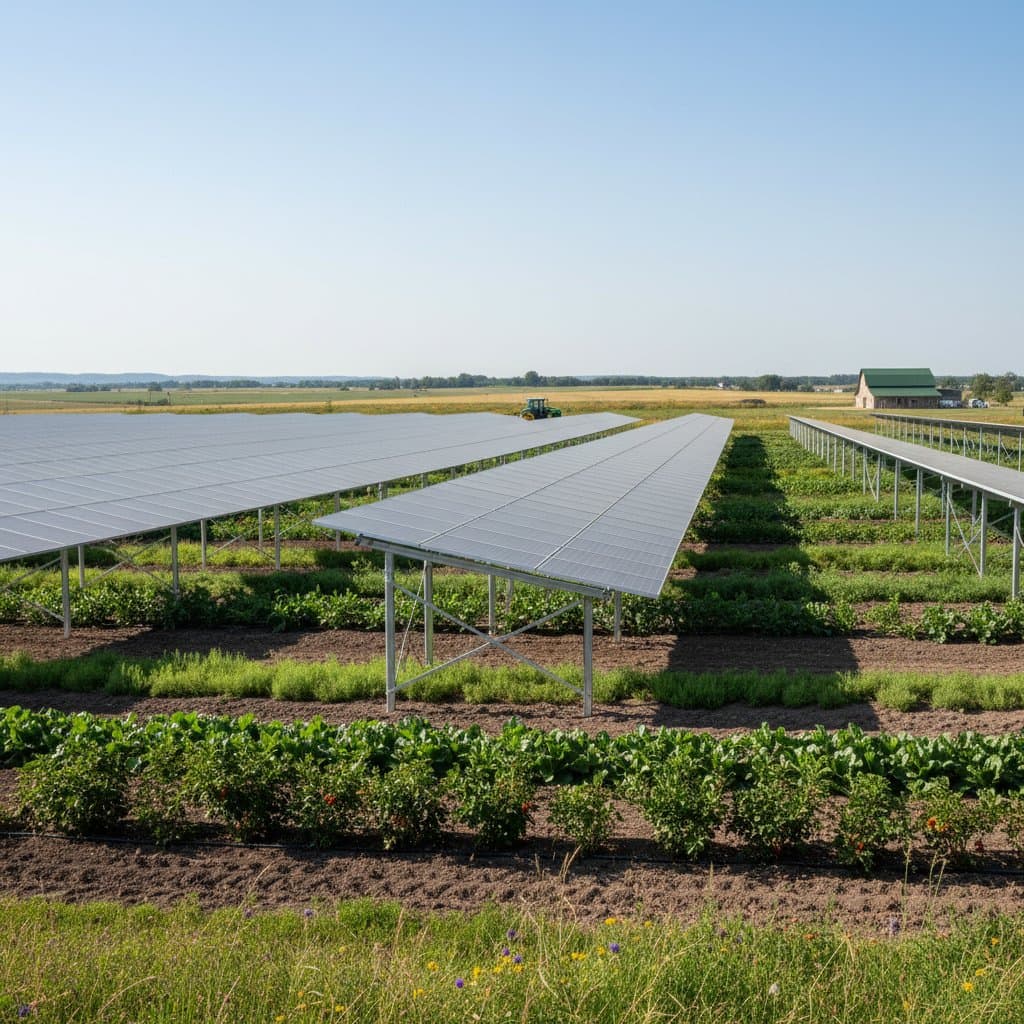Agrivoltaics in 2025: Integrating Solar Energy with Crop Production
Farmers and energy experts increasingly seek methods to produce food and renewable power on shared land. Agrivoltaics, also known as dual-use solar, combines agricultural practices with photovoltaic installations. This strategy allows crops and solar panels to coexist effectively, eliminating the need to prioritize one over the other.
The Importance of Agrivoltaics
In agricultural communities, land allocation sparks significant debate. Traditional solar farms deliver local energy and revenue but encroach on arable space essential for food production. Agrivoltaics addresses this conflict by elevating panels to permit crop cultivation or livestock grazing below, thereby advancing food security, energy autonomy, and economic vitality in rural areas.
The value becomes apparent in practical terms. Elevated panels mitigate plant heat stress, minimize evaporation, and offer reliable income to property owners. In areas with intense summer heat and escalating energy expenses, this integration maximizes land efficiency without requiring additional acreage.
Operational Mechanics
Agrivoltaic systems feature panels mounted at greater heights or with increased spacing compared to conventional solar arrays. Sunlight penetrates at varied angles, providing crops with diffused illumination rather than direct exposure. Monitoring devices assess soil hydration and energy generation, enabling real-time optimizations for both agriculture and power production.
Sunlight photons interact with silicon cells in the panels, dislodging electrons that flow between P-type and N-type layers to produce direct current. An inverter converts this to alternating current for integration into the grid or on-site use. Below, crops harness the moderated light for photosynthesis; shade-tolerant varieties such as lettuce, strawberries, and potatoes exhibit enhanced growth. Livestock, including sheep, graze in the cooler microclimate, which reduces soil compaction and supports pasture health.
Financial Considerations and Returns
Initial expenses for agrivoltaic setups exceed those of standard ground-mounted systems due to reinforced structures and customized configurations. Installation typically costs around 2.20 dollars per watt, versus 1.60 dollars for traditional arrays.
Consider a 1-megawatt installation: total outlay approximates 2.2 million dollars. Annual output reaches approximately 1.3 million kilowatt-hours, generating about 312,000 dollars in value at 24 cents per kilowatt-hour. When factoring in agricultural yields, overall returns accelerate payback to under a decade, influenced by available incentives and regional electricity tariffs.
Landowners may enter power purchase agreements or lease arrangements with developers, securing consistent payments regardless of annual harvest variations.
Policy Incentives and Regulatory Support
Governments at state and federal levels promote agrivoltaics through targeted programs that safeguard agricultural land while fostering renewables. Benefits include investment tax credits, performance-based incentives, and funding for pilot installations. Certain jurisdictions provide elevated tariffs for output from systems adhering to agrivoltaic criteria, such as minimum clearance heights and crop compatibility.
Additional Advantages
Agrivoltaics yields multifaceted gains. Panel shading curtails water demands by up to 20 percent for select crops, preserving soil moisture and lowering irrigation expenses. Inter-row planting of native wildflowers bolsters pollinator populations and ecosystem diversity. Structures shield vegetation from extreme weather, including hail and high winds, serving as natural barriers.
Workers experience improved conditions in shaded zones, with reduced temperatures enhancing safety and productivity during peak seasons. These sites evolve into innovative hubs where renewable energy and regenerative farming intersect.
Implementation Steps
Prospective adopters should initiate with a small-scale trial before full-field deployment. Essential actions include:
- Perform a comprehensive site evaluation, analyzing solar irradiance, terrain gradients, and soil quality.
- Identify shade-adapted crops through variety trials to match local conditions.
- Examine interconnection policies with utilities to clarify export credits and grid protocols.
- Solicit bids from multiple providers, ensuring consistent modeling parameters for output projections.
- Investigate funding sources, including grants, rebates, and tax incentives tailored to dual-use projects.
- Develop a maintenance regimen covering panel cleaning, weed management, and equipment inspections.
Properly engineered systems endure for over 25 years, with efficiency degrading at roughly 0.5 percent annually.
Advancing Adoption
Agrivoltaics demonstrates the potential for unified land use in producing nourishment and electricity. Every acre contributes to both nutritional output and energy supply, fortifying agricultural and community endurance. Landowners ready to proceed should commission a viability analysis, collect utility-specific information, and consult specialists versed in farm-integrated solar solutions. A modest demonstration area often illustrates the dual productivity of harnessing sunlight for sustenance and electricity.
Frequently Asked Questions
Which crops perform optimally beneath solar panels?
Shade-tolerant options like leafy greens, herbs, berries, and root vegetables generally excel in these environments.
Is grazing feasible for livestock under panels?
Affirmative. Sheep prove ideal, as they control undergrowth without harming infrastructure.
Does agrivoltaics compromise solar energy production?
Slight density reductions occur from spacing, yet lower operating temperatures often enhance overall panel performance.
